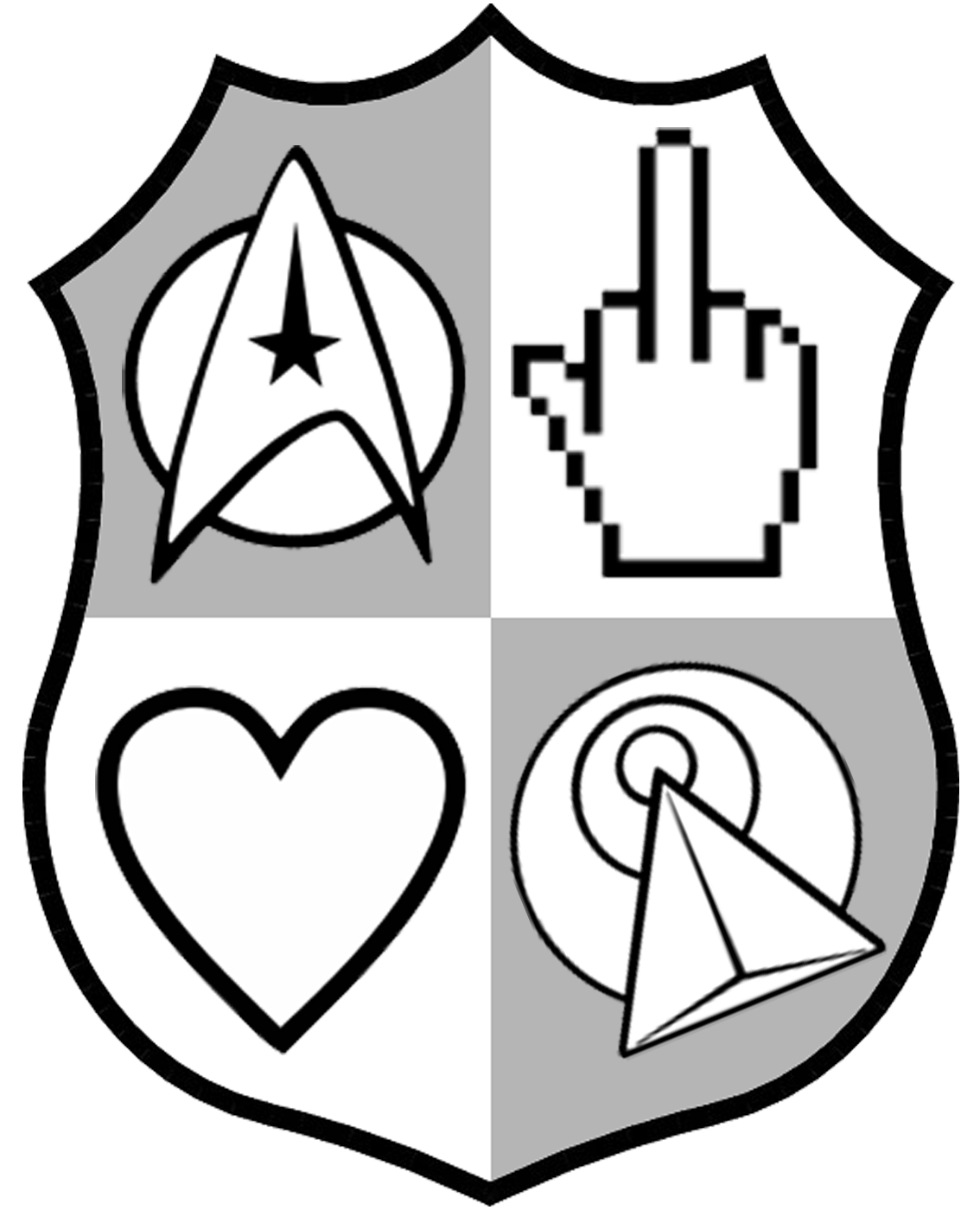Ari
June 23, 2017
Episode 85 – “Star Trek 6: The Undiscovered Country”
We’re finally here, everyone: the last Original Series movie, and arguably the most substantive. Definitely the most 90s, and the most modern, in terms of storytelling.
Undiscovered Country was the first Trek movie that was ride-or-die Space Diplomacy, and as its central plot. It’s all about the first real peace treaty between the Federation and the Klingon Empire, how it came about, and all the shit went down to make it happen.

Like, seriously: that’s why everything happens. The Klingons have a terrible environmental disaster, and the fallout puts them in a position where they have no choice but to consider peace talks. Unfortunately, plenty of people on both sides fear what a true peace may bring. The Klingons fear being weakened and destroyed by both actual conquest and cultural imperialism (on the latter at least they might have a point), and certain elements in the Federation are, in a very un-Federation-like manner, lobbying hard for just, y’know, wiping the Klingons out while they’re down. If you’ve seen the previous two movies, you won’t be surprised to learn that Kirk is in the latter group, or at least thinks the peace talks, and welcoming Klingons into the Federation, is way too risky with not enough reward. But that’s too bad, because Spock, who’s been acting as a pseudo-ambassador to the Klingon Chancellor, just volunteered the entire Enterprise to escort Gorkon to the peace talks.

Naturally, almost the moment the Enterprise meets up with Gorkon’s ship, everything goes horribly, horribly wrong.
The Klingon Chancellor is assassinated, and Kirk and Bones are implicated. They get hauled off to a Klingon prison planet, leaving Spock, the Enterprise crew, and Captain Sulu aboard his shiny new ship the Excelsior (he finally got that promotion), to uncover the real conspirators against the peace, and rescue Kirk and Bones from Rura Penthe.
We all liked this one. It’s a great ride about overcoming prejudices, getting over your shit, and transcending your shitty past in the interest of pursuing a better future. And even in the middle of a murder-mystery-slash-interstellar-political-thriller, it still manages to call out everyone’s bad behaviours.
A+, Undiscovered Country – though to perfectly frank, I’d have awarded that grade for the Klingon cultural appropriation of Shakespeare alone.

This officially marks the end of Original Series! We’re going to be taking a break for the summer, as there will not be a continuous week where all of us are not out of town. We’re also switching over to concurrent watching: we’ll be picking back up with the premiere of Discovery, which was announced this week to be premiering September 24th, 2017. And wouldn’t it be lovely if they actually made that date?
Either way, we’ll see you guys in September. Have a great summer!
Podcast: Play in new window | Download | Embed
Subscribe: Apple Podcasts | Email | RSS
Ari
June 14, 2017
Episode 84 – “Star Trek 5: The Final Frontier”
In this, the officially Most Bananas of all the Star Trek movies, a crazed cult-leader steals the Enterprise and her crew and takes a joyride to the centre of the galaxy to… find… God?

No, really. The central plot of the movie is this:
1. Spock’s long-lost full-Vulcan half-brother, Sybok, lands on the beleaguered Planet of Galactic Peace, aka: Nimbus 3, which as a treaty condition many years ago was declared the shared property of the Klingon and Romulan Empires, and Earth, to be developed jointly (guess how well that went).
2. Sybok uses Vulcan telepathy to brainwash the planet’s wretched hive of scum and villainy and the three ambassadors to his cause, and lure the Enterprise in so he can hijack it.
3. Sybok directs his captives (and followers) to take the Enterprise into the deadly galactic core, where apparently… god… lives.
Except, SURPRISE, it wasn’t really god at all, but a captive super-alien who’s possibly been lying to Sybok for years to trick him into staging a cosmic jailbreak, all to drive home the lesson that so many episodes of Original Series has taught us, namely: Just Steer Clear of Ascended Assholes, They’re Trouble.

This is one of those stories where there’s anywhere between one and five really interesting potential stories that never really got made, because story-wise, this movie is a mess. The underlying mythology Sybok is following suggests that the “god” worshiped on dozens of planets is in fact the same incomprehensibly powerful alien entity, and he just has to meet them. Like, that’s interesting! Especially through the lens of Roddenberry’s die-hard atheism. Of course, in the movie, this turns out to have all been a tragic scam, but it’s also worth noting that Star Trek canon does later firmly establish a creation story for at least half a dozen humanoid races, including humans, Klingons, Romulans, and Cardassians, in the form of a seeded-by-a-dead-race in the vein of Stargate’s Alterrans, in the sixth-season TNG episode The Chase, and IMHO it was a far more interesting take on the whole is-there-a-higher-power question, and a much more Star Trek one.
However, we are willing to forgive almost anything for some high-quality character shenanigans, and this movie has that in spades. The story is totally crazy, but the movie contains a solid half-hour, collectively, of Kirk, Spock, and Bones hanging out during leisure time, camping, and later on, wacky shenanigans and decades-of-friendship banter as the trio lead the cultists on a merry chase through the Enterprise’s back corridors, avoiding capture. There’s also some genuinely affecting bits and pieces where Sybok, flummoxed by the way the unusually strong bond between the trio makes them resistant to his brainwashing, tries to apply his shtick by dragging up everyone’s most painful memories for display to the others and then offering to take the pain away – something that mostly just a) pisses them off and b) makes them more irritatingly loyal to each other. The friendship between Kirk, Spock and Bones is the only consistently structured thing in the movie, and the only one that’s satisfyingly circular. Basically, friendship literally is magic, right up to the front lines defeating a false god.

Star Trek: The Final Frontier. Come for the crazypants religious commentary, but stay for the group hugs.
Next week: the final TOS movie, The Undiscovered Country. After that, we’ll be taking a brief hiatus for the rest of the summer, or until Discovery begins. When will that be? Probably September! But watch this space for updates.
Podcast: Play in new window | Download | Embed
Subscribe: Apple Podcasts | Email | RSS
Ari
June 7, 2017
Episode 83 – “Star Trek 4: The Voyage Home”
Buckle up, nerds, for MY FAVOURITE STAR TREK MOVIE, Star Trek IV: The Voyage Home, AKA: The One with the Whales.
This movie has it all:
1. Hand-claspingly earnest environmentalist commentary
2. The Office-style Fourth-Wall-poking Hey The Past You’re Doing It Wrong plotline
3. A starship crew visiting the super-gross present and having no idea how anything works
4. EVERYONE LIKING EACH OTHER

In Voyage Home, our intrepid crew, on their way back to earth to face a Court Martial for their actions in the previous two movies, discovers that Earth is under attack from a mysterious probe that is whipping the Terran climate into destructive storms and threatens to destroy all life. It’s also beaming some kind of communication signal towards Earth’s oceans, but nobody can understand it. Our heroes do a bit of quick sound mixing and intuit that the signal is – wait for it – whalesong! The aliens are looking for humpback whales! The only problem? That particular species was driven to extinction by crappy humans over two centuries ago.
What’s a heroic crew of technically-right-now-space-pirates to do? Why, travel back in time to find some whales, of course!

This is a great movie for people who don’t know anything about Star Trek, because it’s just… a delight. You get just enough information about the world to be situated, and the chemistry between the characters is solid and established: these people have known each other a long time, and like each other, and work well together. And the plot is wacky, but not so wacky that it drives you up the wall or feels out of keeping with the universe. This is in fact the second time the Enterprise has used the slingshot-around-the-sun method to time-travel, and as an episode format kicks of a tradition of the same kind of time travel story multiple times in each future franchise. Trek’s blatant social commentary is never so blatant as when the world of the future is juxtaposed against our present, and the environmentalism in this movie is so straightforward that most of the dialogue wouldn’t be out of place in an episode of Captain Planet. It’s also the only Trek movie up to this point with no deaths and little to no physical violence.

Highly recommended, 10/10 (or, well, 3/4, if you’re going by hosts, because Kim has no joy in her heart). A fun, happy story with a happy ending. Watch it and have a good time.
Podcast: Play in new window | Download | Embed
Subscribe: Apple Podcasts | Email | RSS
Ari
May 31, 2017
Episode 82 – “Star Trek 3: The Search for Spock”
So, here’s the thing about the second, third, and fourth Star Trek movies: they’re a trilogy. And Search for Spock plays true to form for most two-of-threes: lots of feelings on display and not a whole lot of plot.
But that’s okay! Search for Spock is one of the reasons I tend to disagree with the odd-versus-even Star Trek Movie Rule, because Star Trek 3, while not a very complicated story, is still pretty emotionally satisfying if you’re invested in the characters, and okay, we definitely are.

Basically, the Enterprise returns to Earth to the news that even on top of Spock’s recent, tragic death, everything is garbage: they’re denied permission to travel to Vulcan to attend Spock’s funeral, and Starfleet is retiring the Enterprise (which at this point is over 20 years old) and replacing it with a hot young thing named the Excelsior, a ship Scotty, who is a starship engineer in the 23rd century, thinks is too fancy and complicated and hates with all his being.
It’s hard to say which of these two things is more upsetting to Kirk: being denied the opportunity to grieve his best friend-slash-life-partner, or losing his best girl to the political machinations of a PR-conscious Starfleet, who would rather the Enterprise crew hang around to do damage control over the Genesis incident.
But no worries: here comes Sarek, Spock’s dad and Vulcan Ambassador to the Federation, to hand Kirk & Co. a new quest like a video game NPC: Spock, though his body died, would have transferred his consciousness to someone else given half the chance. Sarek wants it back, and he’s super-pissed at Kirk for leaving Spock’s body behind on Genesis. Sarek thought Spock would have hitched a ride with Kirk, who even Sarek knows was his son’s best friend in the galaxy, but it turns out that Spock hitched a ride with McCoy instead, leaving our favourite curmudgeon space doctor speaking in tongues and having hallucinations while he tries to deal with his passenger.

Kirk, being Kirk, takes one look at the facts and comes to the only logical conclusion: LET’S STEAL THE ENTERPRISE AND GO ROGUE.
In the end, after some frankly forgettable battles with random Klingons and the (tragic?) death of Kirk’s son David, Spock’s body – regenerated to health by his time on Genesis – and his katra (the Vulcan soul) are reunited, and Spock is saved. The crew is reunited, the day is saved, and all is well. I mean… except for the mutiny charges that are no doubt awaiting them back on Earth.

Next time on NSMTNZ: Star Trek: The Voyage Home, AKA: The One with the Whales, AKA: The Best Star Trek Movie, Bar None. Are you excited?
Podcast: Play in new window | Download | Embed
Subscribe: Apple Podcasts | Email | RSS
Ari
May 24, 2017
Episode 81a – “Star Trek: Discovery Trailer”
Have you seen the Discovery trailer yet? Well, spoilers: it definitely looks amazing. Great production values, a diverse cast, and some… okay, totally unrecognizable aliens.
In this mini-episode, we react to the first look at the new Star Trek series. Reactions vary, from the Trek-newbie’s “shiiiiiiny” to the veterans’ “oh dear god what is that,” but it is, after all, only a trailer, designed to entice and frankly, in a lot of ways, mislead. So take what you see with a grain of salt, and don’t be like me, yelling about Klingons in my head 24/7.
What will the new Star Trek really be like? Will it live up to its legacy of radical progressivism, while exploring brave new worlds in the form of asking difficult questions and calling out difficult contemporary truths? Or will it fall into the Enterprise trap of catering to the mainstream at the expense of a lot of its courage? Will it have nuanced space politics and a lot of totally fascinating alien cultures? Will it deliver on the space socialism I, personally, need in order to live?
We’ll just have to wait and see. In the meantime, check out the trailer below.
https://www.youtube.com/watch?v=o_xhb-mGU2w
Podcast: Play in new window | Download | Embed
Subscribe: Apple Podcasts | Email | RSS
Ari
May 17, 2017
Episode 81 – “Star Trek 2: The Wrath of Khan”
We’re here! We’re finally here! We’re finally at my favourite era of Original Trek: all the movies after The Motion Picture!
In this first good Trek movie, one of Kirk’s most powerful nemeses is back for revenge: Khan Noonien Singh, played by the incomparable Ricardo Montalban, has seized the Federation starship U.S.S. Reliant and a whole space station full of civilian scientists, and he’s holding them hostage until Kirk comes to join the party.

But it’s even worse than that: the scientists, including Kirk’s old flame, Dr. Carol Marcus, were working on something potentially terrible: the Genesis Device, a revolutionary terraforming system that in the wrong hands, could unleash unthinkable destruction upon the galaxy.
Sit back and relax, nerds, as we take you into an era of Trek where actors have, at least substantially and to a degree where it interferes much less with what’s on screen, gotten over themselves; where nearly the whole main cast gets something to do; where the design and effects are there to serve the story. And where, perhaps most importantly, we have on-screen explicit confirmation that our first favourite family of obnoxiously-socialist space nerds have been friends for years and actually like each other.
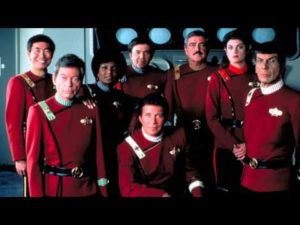
Basically, if everything that came before Wrath of Khan was the fractious, getting-to-know-you period of a madcap 50s romance, the TOS movies from this moment on are like the comfortably-married years. Yes, the movies themselves may vary in quality, but the messaging is on point, and the ensemble has solidified and only continues to grow stronger until the grand handover to the literal next generation. IMHO, from Wrath of Khan all the way to Undiscovered Country, these films, even the bad ones, still leave you with a warm and fuzzy feeling in your heart. These are people who’ve been through hell together and would defend one another to the death… and even beyond.

That’s worth a lot. Even sitting through Final Frontier.
Podcast: Play in new window | Download | Embed
Subscribe: Apple Podcasts | Email | RSS
Ari
May 10, 2017
Episode 80 – “Star Trek: The Motion Picture”
Welcome, nerds, to a new phase in our adventure together: the Original Series Movies!

Star Trek: The Motion Picture cost $35,000,000 USD to make (~125 million in 2017 money), and made (adjusted for ticket price inflation) nearly 290 million dollars, making it the second-highest grossing Star Trek movie of all time, followed only by the first reboot movie in 2009.
Of those two sets of facts, only the second is a minor mystery, because this movie is 2 hours and 12 minutes long and a solid 90 minutes of that is endless panning shots.
Our special guest Elise subtitled this film Star Trek: The Motion Panning, and we can’t really think of a better one. Gene Roddenberry loved him some tiny space robots, to the point where an earlier episode of TOS predicted the interstellar Voyager probes that hadn’t even been launched yet. This movie is semi-loosely based on that episode: tiny space robot sets bravely out into the universe, meets a sentient robot culture, gets a tricked out new ride, budding sentience and an existential crisis, and heads home to seek out its creator.
In both cases, the reveal that filthy ape-descended humans are its creator is something of a disappointment.

There are some positives in this film: a soaring sense of optimism, curiosity and wonder, which of course is Star Trek’s stock in trade. Totally cool-looking (if not well-designed) spaceship interiors. Questions about the nature of sentience and humanity and how we define our own purpose and what value that conversation has for us and for others.
There are also some negatives: landscapes trying harder to out-do Star Wars and 2001: A Space Odyssey than create visuals that supported the story they were trying to tell. There are some catastrophic issues with pacing – actually, catastrophic doesn’t seem strong enough a word: we spend 90 minutes just getting to the conflict, futzing around in space with engine problems and giving endless airing to Kirk’s midlife-crisis-fueled feud with his best girl’s new man, replacement captain of the Enterprise, William Decker.

By the time we actually meet V’Ger, the monster of the piece, and the actual story starts, there are maybe 45 minutes (maybe 30 if you account for the sheer. number. of panning. shots) in which to begin the encounter, suss out the extent of the mystery to be solved, engage with the only other non-crew character in the film, The Probe Formerly Known As Lieutenant Ilia, and solve the mystery. Star Trek stories have a solid, tried and tested structure, and this movie smashes them all to pieces and scatters them into the vacuum of space. It’s like a particularly gruesome transporter accident (which is also given a full ten minutes of screen time), but with plot.
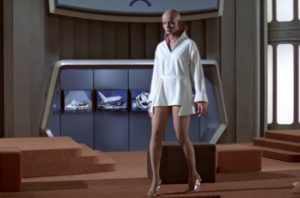
We wanted to spend more time in the story and less time in the show-and-tell of the effects budget, and we wanted more Trek-esque discussion of the nature of humanity and sentience than the maybe 6 minutes we get before – spoiler – Decker gets absorbed by a space robot to join with his true love Ilia in space-robot-afterlife bliss. At least, we’re pretty sure that’s what happened.
The bottom line: this movie would have been 150% more interesting if it had focused 80% more on Ilia and V’Ger and the ethical dilemmas at plan than on The Eternal Pan, but you know what? I still enjoy it. And it’s still not the worst Trek film out there.
That title is reserved for Final Frontier.
We’ll get there.
Podcast: Play in new window | Download | Embed
Subscribe: Apple Podcasts | Email | RSS
Ari
May 3, 2017
Episode 79 – TOS 3×24: “Turnabout Intruder”
Welcome to the VERY LAST EPISODE of the Original Series of Star Trek. On these episodes was based the entire, larger, extensive body of the Star Trek franchise. And while there is more Trek made after TOS than there is TOS, TOS was still the first to go where no one had gone before. Are you tearing up yet?
Great, because this week is definitely enough to make grown adults weep. Our villain of the week is Dr. Janice Lester, who spends 90% of the episode yelling that she should have been a man, which is either a wayyyyyyyy-ahead-of-its-time commentary on gender dysphoria or… just a sloppy, confused and contradictory version of Feminism By Men.
Basically, the Enterprise comes to Camus II on an emergency call, because the archaological expedition has been exposed to deadly radiation. Chief researcher of the expedition? Kirk’s old flame Dr. Janice Lester, who… really really hates him now.
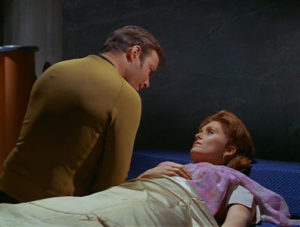
Fair warning: we mess up pronouns allllllll over the place on this one, mostly because the POV is squarely Elsewhere from where it should be.
Basically Janice hates Kirk because… okay, we’re really, honestly not sure. Because she dreamed of becoming a starship captain and was forbidden from doing so? Because she failed Starfleet’s famously-dreaded Psych Test? Because she… apparently specialized in Space Archaology? Because James Kirk scorned her and left her? Because she literally wanted to become James Kirk, up to and including killing him and wearing his skin as a suit?

Janice is an incredible villain. She’s bombastic, clever, and she plans way, way, way ahead. She’s been plotting revenge for twenty years (though again, for what, exactly?), and may or may not have hunted down an ancient alien body-swapping machine for the express purpose of seeing that revenge to its fruition. The main problem with this story, though, apart from its pretty flagrant sexism, is that her motivations are never made at all clear. Janice is definitely depicted as being mentally unstable, and there are certainly notes of “female hysteria” layered over and under and through everything from the costume design to Janice’s dialogue to the other actors’ interpretations of her lines and their body language in relation to her. It’s definitely a relic of the time in which it was created, and the prejudices of its creators are really, really, really obvious, which is both depressing and bad writing.
This would be a very understandable, sympathetic motivation if it were made in any way clear. If this story was about a woman whose ambitions were thwarted for no reason other than her gender, we’d be cheering her on all the way. By all means, steal that guy’s body! Roam the stars with your scientist boyfriend! Become a space pirate!

But we can’t, because the writers couldn’t decide why she was doing anything she was doing, and because of the episode’s other big, big problem: no part of this episode, which is nominally all about Janice Lester’s Grand Revenge, is from Janice Lester’s perspective. When Janice’s body is on screen, it’s being inhabited by James Kirk. And even when Janice-in-Kirk’s-body is making speeches, everything is from the POV of the crew, and Kirk’s closest friends, seeing Kirk psychically possessed by a madwoman. Janice-as-Kirk gets no time alone without the Enterprise crew, and the one scene that contains only Janice!Kirk and her scientist boyfriend, the scene is from the boyfriend’s point of view, and is all about his moral dilemma re: Janice’s Safety vs. Janice’s Happiness (apparently body-swapping is hard on the nerves).

Basically this episode, of all episodes, we wanted to be better, because if it had been from Janice’s POV, it would have been a lot easier to parse and understand and enjoy. As it stands, it comes out as a mess of men writing stories about women’s issues when they have never, to all appearances, either spoken to a woman or looked up the word “feminism” in the dictionary.
Podcast: Play in new window | Download | Embed
Subscribe: Apple Podcasts | Email | RSS
Ari
April 26, 2017
Episode 78 – TOS 3×23: “All Our Yesterdays”
IN THIS, THE PENULTIMATE EPISODE OF THE ORIGINAL SERIES, we visit the planet Sarpeidon, a planet whose star is about to go supernova. Setting aside the crucial travel advisory that three hours out from a supernova, kids, do not beam down to the surface of a planet, this feels like a little late to be trying for… a last-minute anthropology scan? Last-ditch rescue attempt? We never know exactly what their plan was, only that they “came as soon as [they] heard” that the star was going nova.
Anyway, Kirk, Spock & McCoy beam down to find the planet… abandoned. Spookily, entirely abandoned. Except for this one guy, the last person on the planet, who is, in keeping with what one might expect of our own reality, a librarian.

Well, technically, we’d argue that Mr. Atoz is actually an archivist, but he describes himself as The Librarian, in charge of sending people “wherever they wanted to go.” Our heroes’ first conversation with Atoz is rife with frustration and accidental misdirection, wherein Kirk, Spock or Bones asks “uhhhhh where did everybody go? you definitely don’t have space travel,” and Atoz says “they left,” and then tries to hurry them along towards choosing their own destinations.
Long story short, the Library is a repository of periods of the planet’s past, and the Librarian’s primary duty is running the Atavachron, a time portal that sends its passengers to any period in the planet’s past whose details are contained in the Library.
So naturally, our three stars immediately end up blundering through the portal and accidentally travelling back in time to variously shitty periods in Sarpeidon’s history: Kirk by himself to some weird combo of Victorian Dublin and pre-Revolutionary France, and Spock and Bones to the planet’s last ice age.
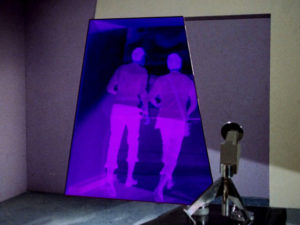
Naturally this episode boils down to a) the wacky hijinks of our heroes while stranded in the past and b) the emotional conflict encountered by one or more of said heroes upon their return to the present. Specifically, we get an intensely soapy romantic interlude between Spock and the female guest star, Zarabeth, who was deliberately exiled to Sarpeidon’s ice age and has been physically altered so that she can never return.

In the end all is resolved, and the Enterprise, with its full complement, floors it out of Sarpeidon’s solar system in the nick of time. Narratively satisfying, if astrophysically dubious.
Tune in next week for the very last episode of TOS! Are you excited? We’re pretty excited.
Podcast: Play in new window | Download | Embed
Subscribe: Apple Podcasts | Email | RSS
Ari
April 20, 2017
Episode 77 – TOS 3×22: “The Savage Curtain”
So hey guys, spoiler: this episode is total nonsense. Basically, the Enterprise is at A Planet. Why? It’s never explained. But almost as soon as they arrive, a bunch of sentient-lava aliens kidnap Kirk and Spock, spontaneously generate them two new BFFs in the form of their personal long-dead historical Faves, and pit them against four Black Hats from Space History. White Hats vs. Black Hats, Space Gladiatorial History Edition.
Oh, and did I mention Kirk’s Space History BFF is Abraham Lincoln?
Yeah, this is that episode.

Yes, we’ve seen this before. Frankly, we’ve seen this done better: The Gamesters of Triskelion at least had some interesting world-building and a great female character in it. This time? The plot amounts to the two teams throwing rocks and sharpened sticks at each other and having vague, totally-unanchored-to-the-story conversations about the nature of Good and Evil. That’s why the lava-monsters are doing all this, by the way: apparently they evaluate the founding philosophies of passing alien races by… pitting them against one another in guerilla combat.
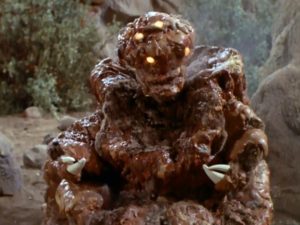
Setting aside the minor quibble with the idea that “Good” and “Evil” are somehow equal, fundamental human philosophies, this is a totally nonsensical way of evaluating alien cultures. I mean, blah blah relativism, but wouldn’t it be simpler to just call up passing ships and ask them to explain themselves? Plus, we’re never told whether the lava monster is evaluating Human ideas of Good and Evil (capital letter, for once, appropriate!) or like, humanoid ideas of the same two ideas. Team Good includes two Vulcans (one Spock and the other the ancient Vulcan philosopher and Doomed Pacifist Surak) and Team Evil includes two human (Genghis Khan and a genocidal psychopath from the dark and mysterious Early Twenty-First Century that Star Trek canon likes to dance around and never explain directly) and two aliens, one of whom is Kahless the Unforgettable, Klingon culture’s most significant and legendary figure.

Aside: we can say a lot about wartime propaganda informing the interpretation of Klingons as evil and barbaric vs. the Noble Warrior Poets we know and love from later outings, and the relative, overall shittiness of the portrayal of Klingons in TOS vs. every later portrayal of Klingons, but I’d like to take a moment to register my outrage at this, our first experience of Kahless, who later is seen and portrayed and discussed as a very different and much more nuanced character than we get here. Here, we get this asshole in really bad brownface makeup, who is all about dishonourably stabbing everyone in the back.
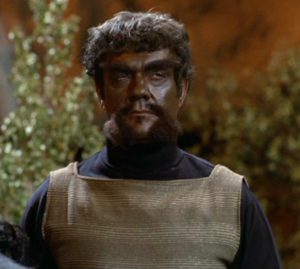
The problem with this so-called contest of philosophies is that the parameters are meaningless. The lava-monsters don’t want to understand the differences between Good and Evil (because apparently a species advanced enough to generate living beings out of pseudo-inanimate matter has never heard of an artificial cultural binary), it wants to see which is stronger, but both its contenders and its rules for the fight are constantly changing and totally fail to establish themselves as a solid binary. Nobody “evil” thinks of themselves as Evil. And the two teams are fighting for different outcomes: the Black Hats for “power” and the White Hats for the safety of those they’re sworn to protect.
We’re supposed to see the victory of the White Hats as some meaningful statement about the fundamental superiority of Good for Good’s Sake, but it’s really, really not; it’s the victory of rational minds over a fucking irrational conversation on par with the one you have about immigration policy or income tax over Thanksgiving dinner, which as we all know, is a battle no one can win, because you’re having two different conversations. You can only escape.
Podcast: Play in new window | Download | Embed
Subscribe: Apple Podcasts | Email | RSS
